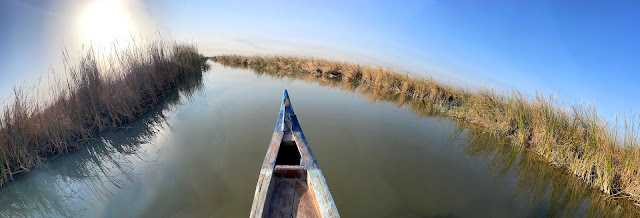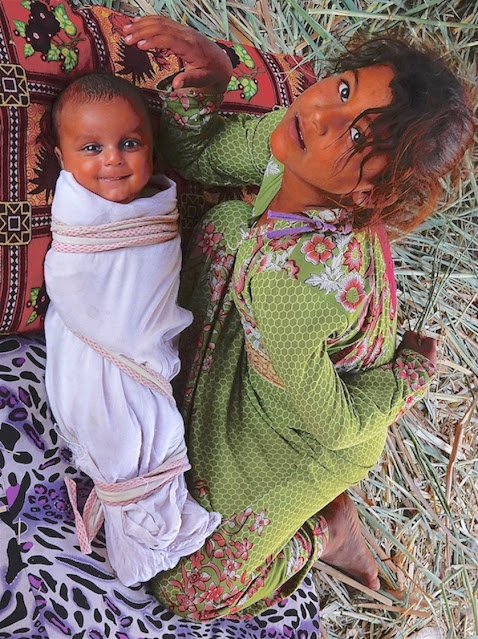In this post we drive from Nasariyah to the town of Al-Chibayish in the Mesopotamian Marshes near where the Tigris Rover merges with the Euphrates River, take an extensive boat trip through the marshes, have brekkie on a reed house in the marshes, a local fish lunch back in the town of Al-Chibayish and then a long drive back to Baghdad.
Our 4am departure today was well worth it. Watching the sun rise over the desert and eventually seeing the calm waters of the Euphrates reflecting gold under the rising sun. We were met by four long boats in the small village of Al-Chibayish and began our 10km cruise into the maize of marshes to reach a family on a reed and mud island approx. 30min later.
The Mesopotamian Marshes, also known as the Iraqi Marshes, are technically a wetland area located on the floodplains of the Euphrates and Tigris rivers bound by the cities of Basra, Nasiriyah, Amarah and a portion of southwestern Iran. The unique wetland landscape is home to the Marsh people (Maʻdān in Arabic), descended from the Ur, Sumer and Babylon civilisations, who have developed a unique culture tightly coupled to the landscape – harvesting reeds and rice, fishing and herding water buffalo.
Draining of portions of the marshes began in the 1950s and continued through the 1970s to reclaim land for agriculture and oil exploration. In the late 1980s and 1990s, during the presidency of Saddam Hussein, this work was expanded and accelerated to evict Marsh people from the marshes. Half the population was displaced under Hussein. Before 2003, the marshes were drained to 10% of their original size. After the American overthrow of Hussein in 2003, the marshes have partially recovered but drought along with upstream dam construction and operation in Turkey, Syria and Iran have hindered the process. Originally the marshes covered a massive area of 35,572 square kilometres (half the size of Tasmania !!!) but now have been reduced to 9% of the original size but protected under 2016 UNESCO.
There are now 56 families living on the marshes in the Al-Chibayish area out of a total of 20,000 throughout the rest of Iraq and Iran around the Persian Gulf. The Maʻdān live inside domed and rectangular shaped dwellings made entirely of harvested reeds. A typical dwelling for a family of 4 takes husband and wife 12 days to build. The dwellings are renewed every few years since the reeds tend to rot with the heavy rain that comes in winter. Water Buffalo are not eaten but their milk is sold to make a special cream that Iraqis use for deserts. The buffalo poo is dried and used as fuel for fire to cook. There are also chickens and ducks that provide eggs and meat. Fish is also a staple. There are no veggies or fruit grown – these are purchased along with flour and water in exchange for buffalo milk and eggs in Al-Chibayish.
The family at our first stop kindly made us a brekkie of omelette, yogurt, sesame seed paste (tastes like vegemite) and sweet molasses (tastes like honey) all wrapped in thin circular pita-style bread they make themselves in round oven like vases made from the clay from the river bed – they look like Indian tandoors. The Maʻdān comprise 5 different tribes which all speak their own dialects of Arabic often referred to as Mesopotamian Arabic. They are all Muslims. Some tribes closer to the Persian Gulf also grow rice, barley and wheat since the conditions there support it. Children are mostly schooled by their parents but many our now sending their kids to schools in the closer small villages.
Our second stop was a family only 2km further downstream. This was more a rest and water stop and an opportunity to play with a larger group of children.
On our return to Al-Chibayish we were the guests of the lead boat driver named Abu Haider. This guy is a real character, always funny and very inviting. He put on a terrific catfish lunch and told us stories of the Karbala Battles. Abu Haider is in fact famous with tourists in the past and makes films that he puts on YouTube – check them out !!!
Before lunch I was fortunate to achieve one of my dreams in life – to swim 2km in Tigris or Euphrates Rivers where human civilisation was born !!! Abu Haider chaperoned me in his long boat as I made my way downstream towards the Persian Gulf. Only 40km ahead of me the Tigris meets the Euphrates that I was in and it is at this junction, that legend has it, was the location of THE GARDEN OF EDEN or Heaven or Paradise !!! Just think if it – I was swimming towards Heaven !!! The fresh water was a pleasant 25C, cloudy yellow with a very slimy muddy silt sea floor that you cannot stand on or you will sink like quicksand !!! I swam closer to the middle of the river where the depth reaches an average of 4 metres. Abu Haider was very impressed with my swim but he sailed so close to me that he filled my lungs with two-stroke from his outboard. Iran was only 70km ahead of me and Kuwait 120km where the Persian Gulf is located. Amazing that I got to “swim in Iraq” something I never imagined as I flew countless flights from Australia to Greece over this vast barren yellow desert landscape. I often think what would have happened with civilisations and history if the Tigris and Euphrates never existed – there is no doubt that these rivers are indeed “the rivers of life” !!!
It took us 5hrs to drive back to Baghdad to position us for our journey north towards the Kurds over the next few days. We made a stop at BAB AL-AGHA bakery which is the most famous bakery and sweet (pastry) shop not only in all of Baghdad but in all of Iraq. Just the incredibly beautiful smell of the hundreds of sweets is enough to make you full !!!
What a day – enjoy the Mesopotamian Marshes and the Garden of Eden…




























No comments:
Post a Comment